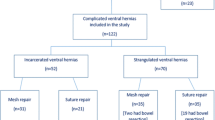Abstract
Purpose
There is a common doubt regarding the application of polypropylene mesh to treat incarcerated and strangulated hernias due to the possibility of surgical site infection. We aimed to investigate the results of mesh repair of incarcerated and strangulated hernias, and to evaluate the incidence of wound infection and recurrence.
Methods
One hundred and fifty-three consecutive patients with incarcerated and strangulated hernias underwent surgery with mesh repair. The patients were divided into two groups: a resection group and a nonresection group. Fisher’s exact test, the Chi-square test and independent samples t test were used to determine the statistical significance level (p < 0.05).
Results
While 53 patients required organ resection, the remaining 100 patients did not. The most frequently incarcerated organs were the omentum (86), small bowel (74) and colon (15). Most of the resections were performed in the omentum (36), small bowel (23) and colon (2). While five of the 53 patients (9.4 %) in the resection group developed wound infections, no infections were observed in the nonresection group (p = 0.004). The infection rate in all patients was 3.3 % (five of 153 patients). None of the infected patients required mesh removal. There were no mortalities or recurrence in either group.
Conclusions
The findings revealed effective and safe usage of mesh along with antibiotic therapy in patients undergoing incarcerated and strangulated hernia repair.
Similar content being viewed by others
References
Catena F, La Donna M, Gagliardi S, Mingolla P, Avanzolini A, Pasqualini E, et al. Use of prosthetic mesh in complicated incisional hernias. Minerva Chir. 2002;57:363–9.
Henry X, Randiamanantsoa V, Verhaeghe P, Stoppa R. Is there a reasonable role for prosthetic materials in the emergency treatment of hernias? Chirurgie. 1994;120:117–20.
Mauch J, Helbling C, Schlumpf R. Incarcerated and strangulated hernias-surgical approach and management. Swiss Surg. 2000;6:28–31.
Wysocki A, Pozniczek M, Krzywon J, Bolt L. Use of polypropylene prostheses for strangulated inguinal and incisional hernias. Hernia. 2001;5:105–6.
Arabamson J. Hernias. In: Zinner MJ, Schwartz SI, Ellis H, editors. Maingot’s Abdominal Operations. Englewood Cliffs: Prentice-Hall; 1997. p. 479–80.
Citgez B, Yetkin G, Uludag M, Karakoc S, Akgun I, Ozsahin H. Littre’s hernia, an incarcerated ventral incisional hernia containing a strangulated meckel diverticulum: report of a case. Surg Today. 2011;4:576–8.
Yerdel MA, Akin EB, Dolalan S, Turkcapar AG, Pehlivan M, Gecim IE, et al. Effects of single-dose prophlactic ampicillin and sulbactam on wound infection after tension-free inguinal hernia repair with polyporpylene mesh. The randomized, double-blind, prospective trial. Ann Surg. 2001;233:26–33.
Abdel-Baki NA, Bessa SS, Abdel-Razek AH. Comparison of prosthetic mesh repair and tissue repair in the emergency management of incarcerated para-umblical hernia: a prospective randomized study. Hernia. 2007;11:163–7.
Atila K, Guler S, Inal A, Sokmen S, Karademir S, Bora S. Prosthetic repair of acutely incarcerated groin hernias: a prospective clinical observational cohort study. Langenbecks Arch Surg. 2010;395:563–8.
Papaziogas B, Lazaridis CH, Makris J, Koutelidakis J, Patsas A, Grigoriou M, et al. Tension-free repair versus modified Bassini technique (Andrews technique) for strangulated inguinal hernia: a comparative study. Hernia. 2005;9:156–9.
Bessa SS, Katri KM, Abdel-Salam WN, Abdel-Baki NA. Early results from the use of the Lichtenstein repair in the managment of strangulated groin hernia. Hernia. 2007;11:239–42.
Derici H, Unalp HR, Nazli O, Kamer E, Coskun M, Tansug T, et al. Prosthetic repair of in incarcerated inguinal hernias: is it a reliable method? Langenbecks Arch Surg. 2010;395:575–9.
Wysocki A, Kulawik J, Pozniczek M, Strzalka M. Is the Lichtenstein operation of strangulated groin hernia a safe procedure? World J Surg. 2006;30:2065–70.
Pans A, Desaive C, Jaquet N. Use of a preperitoneal prosthesis for strangulated groin hernia. Br J Surg. 1997;84:310–2.
Karatepe O, Adas G, Battal M, Gulcicek OB, Polat Y, Altiok M, et al. The comparison of preperitoneal and Lichtenstein repair for incarcerated groin hernias: a randomised controlled trial. Int J Surg. 2008;6:189–92.
Sanabria A, Domínguez LC, Valdivieso E, Gómez G. Prophylactic antibiotics for mesh inguinal hernioplasty: a meta-analysis. Ann Surg. 2007;245:392–6.
Glassow F. Is postoperative wound infection following simple inguinal herniorraphy a predisposing cause for recurrent hernia? Can Med Assoc J. 1964;91:870–1.
Conflict of interest
None.
Author information
Authors and Affiliations
Corresponding author
Rights and permissions
About this article
Cite this article
Topcu, O., Kurt, A., Soylu, S. et al. Polypropylene mesh repair of incarcerated and strangulated hernias: a prospective clinical study. Surg Today 43, 1140–1144 (2013). https://doi.org/10.1007/s00595-012-0397-0
Received:
Accepted:
Published:
Issue Date:
DOI: https://doi.org/10.1007/s00595-012-0397-0




